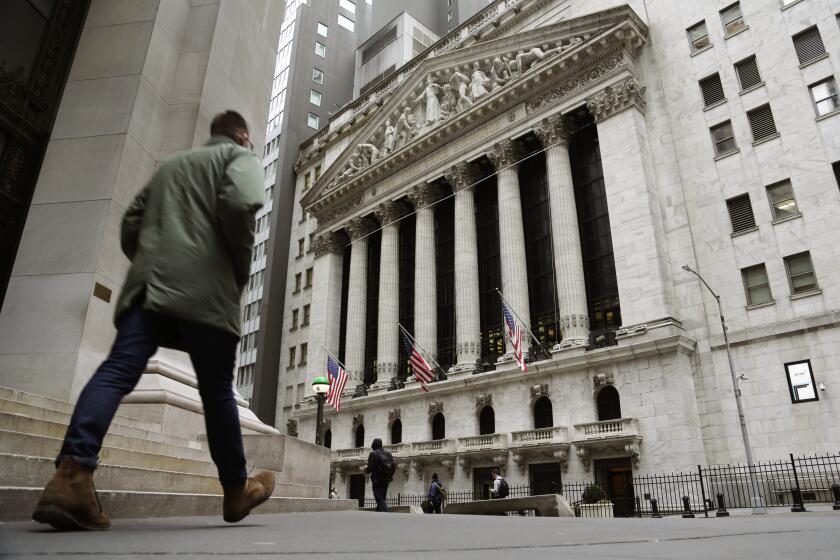Retailers Need to Lower Credit Card Rates
- Share via
California’s big retailers want to make more money from their credit cards. Retailing is “having the struggle of its life,” they say, and any regulation of finance charges would be “the last straw.” Like every other industry, they want deregulation--specifically, the freedom to charge whatever interest they want on their credit cards.
Trust them: They can’t answer for every little marginal retailer out there, but the big guys will surely keep rates reasonable. If they don’t get that freedom, they’re going to cut a lot of people off their credit rolls; they just might get out of credit entirely.
That, of course, would be like shooting themselves in the foot. Retail credit operations rarely make money, and were never expected to. They’re marketing tools, intended to draw customers--like advertising or free parking. They’re much more important to the retailers involved than to their customers: More than 60% of their business comes from credit card customers. Whining aside, it’s unlikely that they’d give them up, and if they do, it tells us a lot about what’s wrong with retailing today.
For almost three years now, California retailers have been allowed to set their own rates, like retailers in 16 other states. Before 1989, California law capped interest rates at 18% on outstanding balances under $1,000 and 12% on balances over $1,000, and come next January they will be capped again, if the retailers’ legislative bill establishing permanent deregulation doesn’t pass. (Indeed, it is their bill: Calls to its sponsor, state Sen. Ralph Dills (D-Gardena), are returned by the California Retailers Assn. Some civics lesson.)
This thrilling three-year trial of rate competition drove most major retailers up to 19.8%. Oddly, no one seized the chance to go down from 18%. For all the talk of competition, says Gail Hillebrand, an attorney in the San Francisco office of Consumers Union, “why haven’t we seen anyone compete on rate?”
To most consumers, none of this is very pressing. The cards themselves are an anachronism, given today’s all-purpose bank cards, accepted by all but the retailers offering their own cards. They are, however, easy to get, offering access to credit for people with scant or high-risk credit histories. And they give customers first access to store sales and promotions.
Still, no one uses them much. According to a study of California retail credit by Ray McAlister, professor of business administration at the University of North Texas, such customers averaged only eight purchases a year, totaling $445 annually. And they don’t care about the rate, if they even notice it: One big store sent out a million notices of its rise to 19.8% and got only 40 complaints.
The rates, and the credit itself, may be an issue only for the poor, but “a major issue, a class issue,” says Ken McEldowney, executive director of Consumer Action in San Francisco. Unable to get credit elsewhere, they’re captive customers of marginal retailers, who cover high risks with high prices and high rates. Lacking choice, these customers need protection: If regulation exists just for them, it’s justified.
As for other retailers, less marginal, more vocal, they probably get more out of their credit operation than their customers, whatever the cost. They get a mailing list to use and to sell to other marketers. They get access to identified customers when retail customers are hard to come by, and while that access is worth only eight purchases a year on average, it provides more than 60% of their sales.
Granted that credit card operations are costly. Stores “lose” money on them. They’ve always “lost” money on them. It’s worth it if it buys enough customers, and apparently it doesn’t, at least not at these rates.
The whole rate haggle could be endless, and inconclusive. The retailers like to argue that the difference between an 18% rate and 21% “would cost a typical California credit card customer only $3.50 additional per year” per card. Consumers Union says the trial deregulation already cost California consumers $106.4 million each of the three years. Pick your side.
Nobody needs this. The country needs less consumer debt. Consumers, poor and profligate alike, need fewer cards and better payment plans--preferably something that encourages them to notice the rate and the balance. Retailers, who are gushing blood, need more than Band-Aid therapy at $3.50 a customer.
What they need is a marketing tool that attracts more than eight purchases a year. What about lower credit rates, shorter terms, cash-only sales instead of those seductive deferred-payment promotions? What about some creativity? Isn’t that what competition’s all about?
More to Read
Inside the business of entertainment
The Wide Shot brings you news, analysis and insights on everything from streaming wars to production — and what it all means for the future.
You may occasionally receive promotional content from the Los Angeles Times.










